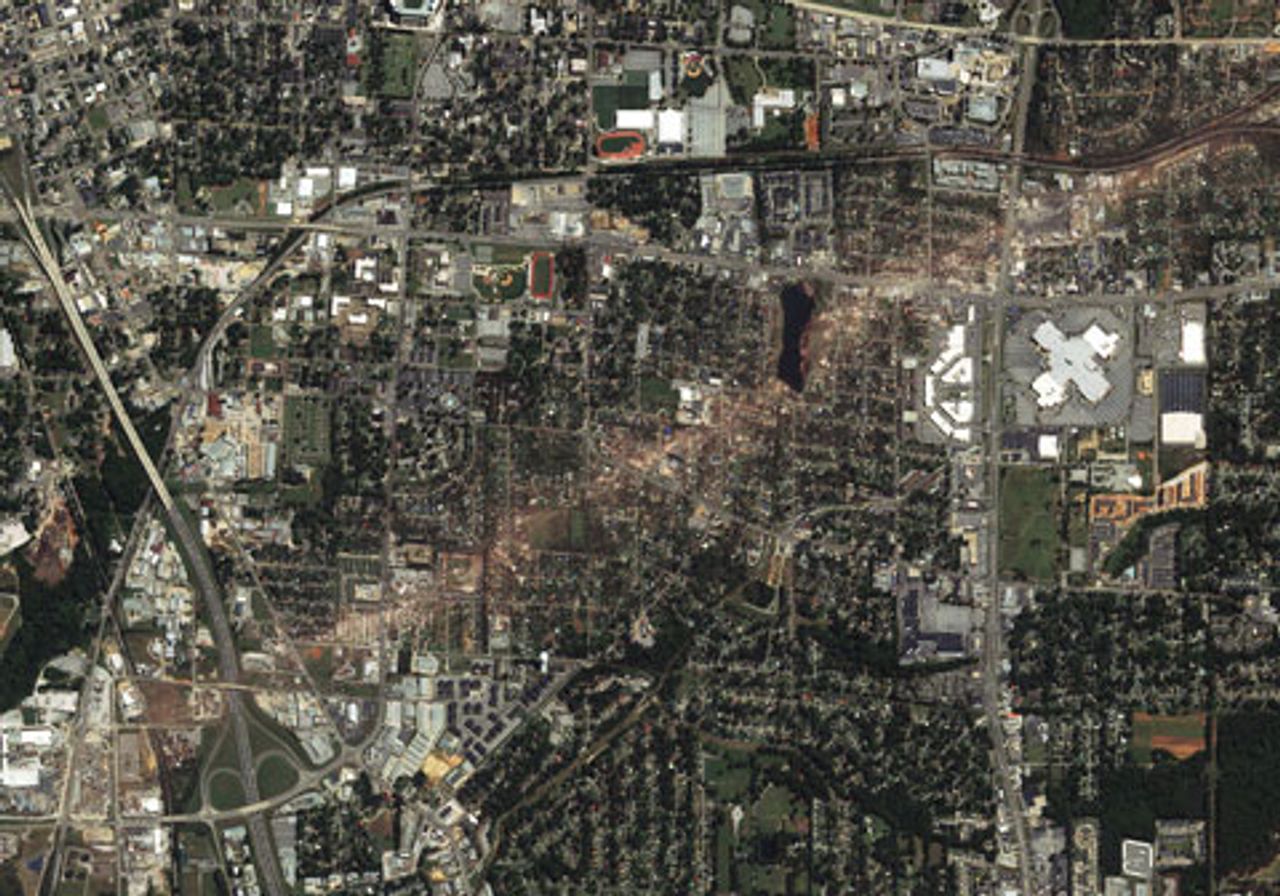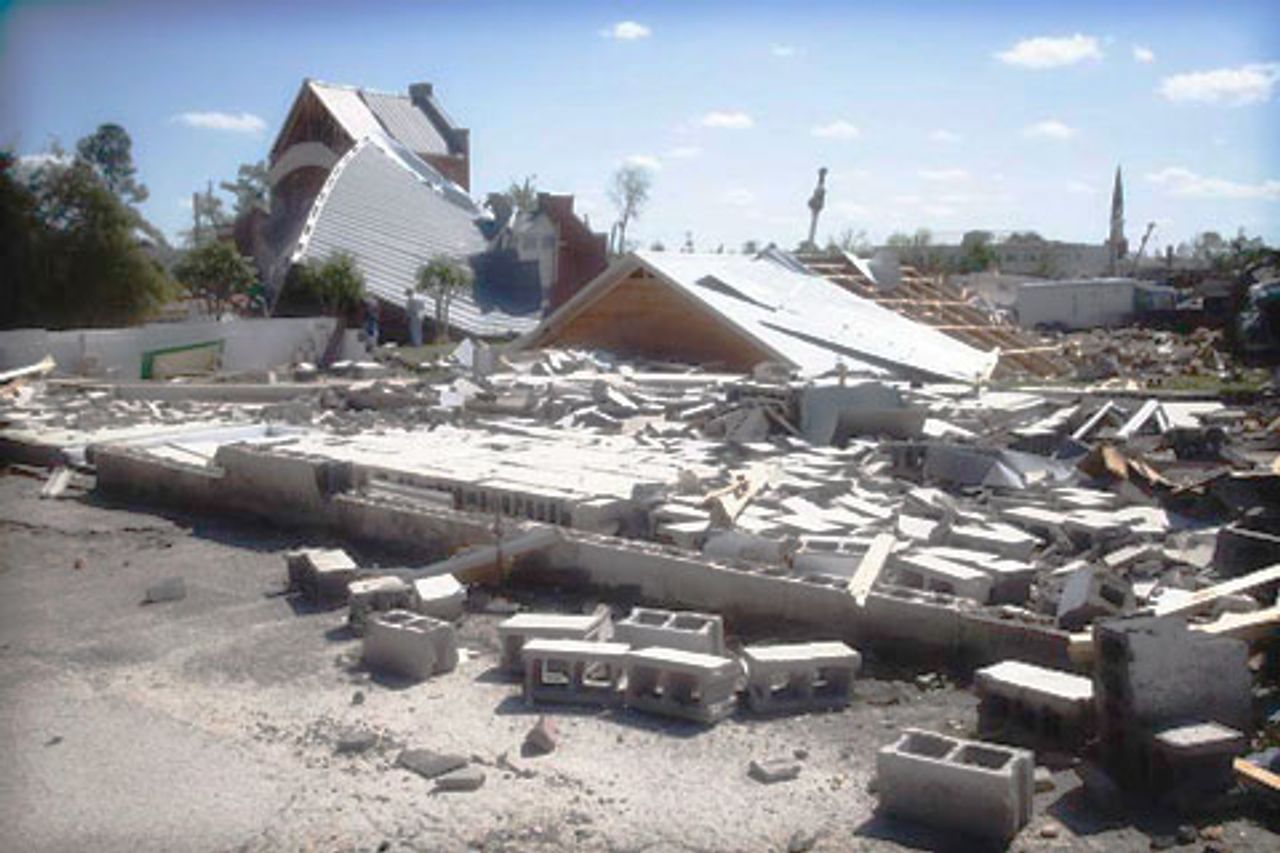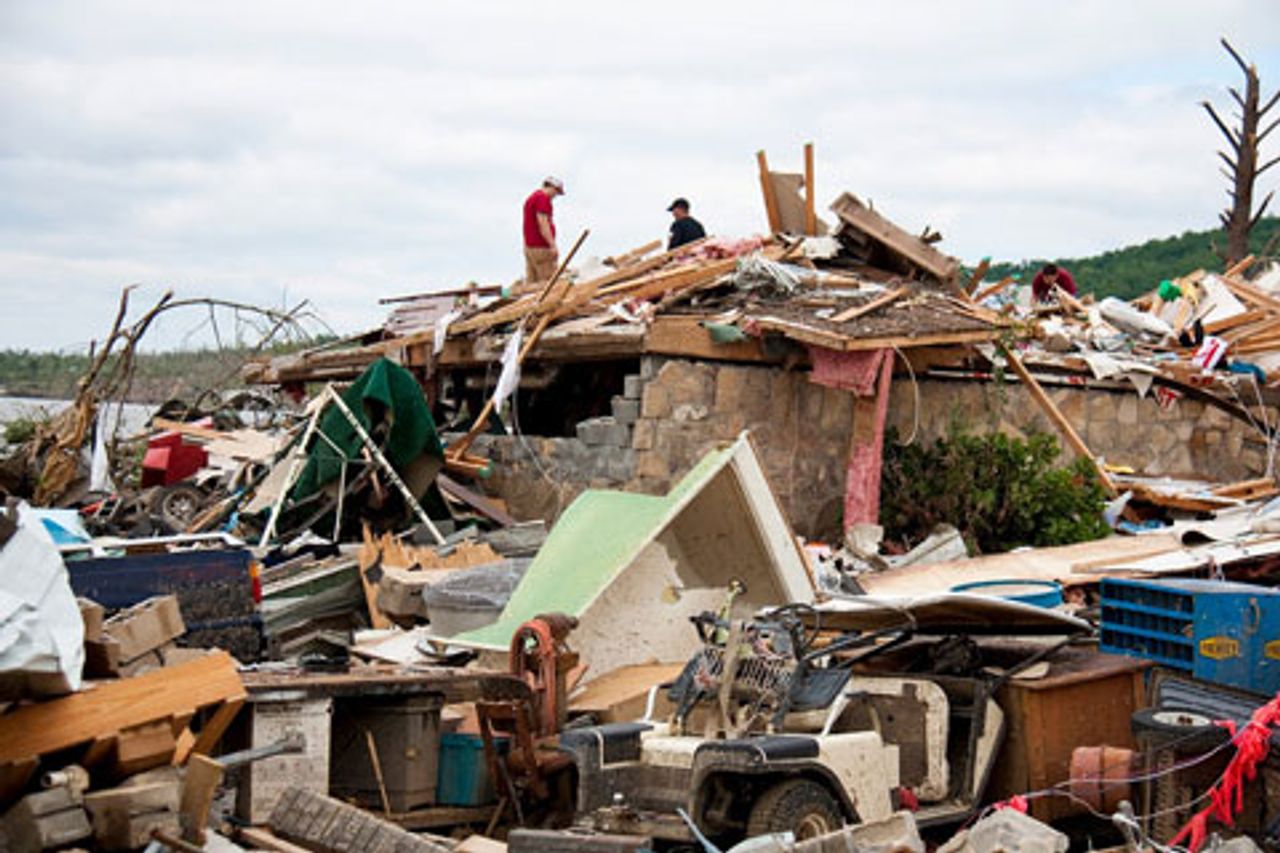The death toll from the April 28 storm system continues to rise as rescuers dig through rubble in towns across the Deep South. At least 319 people were killed in six states, with Alabama reporting 228 deaths. Thousands more were injured or made homeless, and a number of people remain missing.
One million households across Alabama were still without power Friday, and many towns were facing water and fuel shortages. In rural areas, towns grappled with a lack of basic medical or morgue supplies.
 Satellite photo of downtown Tuscaloosa, shows the reddish path of the tornado [Photo: Digital Globe]
Satellite photo of downtown Tuscaloosa, shows the reddish path of the tornado [Photo: Digital Globe]Among larger urban areas, the city of Tuscaloosa was hardest hit, with 45 confirmed dead and more than 990 injured. Mayor Walter Maddox told the press Friday that the search for survivors would go on for 24 to 48 hours longer, then the response would shift to recovering the dead. Maddox’s assistant announced they were bringing in cadaver dogs to search obliterated apartment buildings.
The tornado destroyed the city’s emergency and police department buildings, making rescue of the injured more difficult.
In some cases, residents have resorted to digging with their bare hands into collapsed apartment complexes for victims, according to local news reports. “They’re looking for five kids in this rubble here,” a nurse told the New York Times in her ruined Tuscaloosa neighborhood Friday. “They’re mostly small kids.”
At Tuscaloosa’s DCH Regional Medical Center, more than 100 patients were being treated for blunt trauma, broken bones and serious tissue evulsions. The hospital has so far treated at least 600 patients, including many injured children who arrived without parents. Doctors report that more than 50 children have come to the emergency room alone since Wednesday.
Statewide, hospitals have treated 2,122 storm victims. Speaking to the Wall Street Journal Friday, a doctor at the University of Alabama trauma center in Birmingham described an influx of dozens of patients with injuries “much like we would see in motor-vehicle collisions… The severity of the injuries was remarkable to us.”
On Friday, President Barack Obama surveyed damage in parts of Alabama along with Republican Governor Robert Bentley. Obama signed a disaster declaration late Thursday, promising federal aid to those who apply for funds. Federal Emergency Management Agency (FEMA) Director Craig Fugate promised Friday that a warehouse near Atlanta, Georgia, would soon begin disbursing packs of water, food, infant formula, and tents to disaster areas.
The White House and FEMA are eager to avoid appearances of a slow response, like that of the Bush administration after the Hurricane Katrina disaster in 2005. At the same time, officials have repeatedly stressed the leading role of local agencies in the recovery efforts, with the federal agency playing merely “a support role.” When asked by journalists about the federal efforts Friday, FEMA head Fugate insisted, “Everybody wants to know who’s in charge. I can tell you this. Alabama’s governor is in charge. We’re in support.”
The response capabilities of state and local authorities, however, are crippled by the tremendous scale of damage and limited resources. Governor Bentley commented from Tuscaloosa Friday, “We’re going to have to have help from the federal government in order to get through this in an expeditious way.”
“They don’t yet have an infrastructure to handle donations or volunteers,” Cullman County emergency management director Phyllis Little told a Birmingham television station. “Right now, we’re not in a ready mode to receive donations or volunteers yet. We are working toward that. Hopefully by tomorrow or Sunday, I’ll have answers.”
 A scene in Cullman after the storm [Photo: Tabitha Kaylee Hawk]
A scene in Cullman after the storm [Photo: Tabitha Kaylee Hawk]In the devastated town of Cullman rescue efforts were hamstrung by difficulties in getting fuel for vehicles. “Emergency responders have been waiting in hours’ long lines with other drivers to get gas at stations without power,” the Associated Press reported. A resident told reporters, “I just can’t understand this. Are people coming to help us? We feel all alone.”
Like most US states, Alabama was already confronted with a barebones budget and dire economic prospects before the disaster, the financial toll for which stands to be in the billions of dollars. Affected municipalities, including the largest city of Birmingham, are currently deep in debt and will be dependent upon federal aid to rebuild.
Governor Bentley has authorized the deployment of 2,000 National Guard troops to assist local agencies in rescue operations. Mississippi and Georgia also declared states of emergency for impacted regions. Churches and religious organizations, including many volunteers, have comprised a significant portion of the initial responders.
Media reports of Obama’s brief tour of Tuscaloosa describe a wary response from some residents. One city resident, interviewed by an NBC crew as he pushed a shopping cart of his family’s belongings down the street, commented, “Hopefully he’ll give us some money to start over. Is FEMA here? The only place I’m hearing anything is at the Red Cross center.”
“People are panicking, buying up everything,” a convenience store manager told ABC news. Gas stations not damaged in the storm were reportedly running out of fuel by mid-morning.
A similar situation confronted residents of Pleasant Grove, a community outside of Birmingham that sustained heavy damage in the center of town. Pleasant Grove is home to a large elderly population with pressing medical needs. Local authorities in both Pleasant Grove and nearby Concord had blocked off traffic to prevent potential looting, but in so doing, relatives said they were unable to locate their loved ones. Relatives said they were made to park alongside the roads outside the towns and walk in, or reported being turned away by officials. (See, “Tornadoes kill at least 290 in US South”)
 Surveying through rubble [Photo: GAin USA]
Surveying through rubble [Photo: GAin USA]In the rural northeastern counties, local governments are overwhelmed by the damage. In Hackleburg, Alabama where at least 27 people were killed, officials were storing bodies in a refrigerated truck because of a body bag shortage. The local fire station, police department, school, and the sole grocery were all decimated by the storm, and the town had no electricity, telephone communications, water, or other basic services.
In Mississippi, 51 of the state’s 82 counties reported storm damage. In the small northeastern town of Smithville, 17 residents were killed and another 17 were reported missing. More than 150 homes were destroyed, and the town was evacuated on Thursday night because of the scale of the damage.
In rural areas throughout the South, damage assessment is likely to take longer than a week. Largely poor residents in these areas were unprepared to weather the storms due to housing stock missing basements or in some cases even foundations.
In some Deep South counties, mobile homes make up as much as 30 to 40 percent of housing units, according to a 2008 study by Northern Illinois meteorologist Walker Ashley. Such housing is extremely vulnerable to tornado damage. Frequently tethered to concrete slabs by nylon straps, mobile homes are fabricated out of aluminum, particle board, and other inadequate material. Ashley’s study found that mobile home residents make up 44 percent of all tornado fatalities nationwide.
Rapid growth in some areas of the South, including in suburban areas, has consisted of mobile home parks or cheaply fabricated subdivisions lacking adequate foundations, basements or storm shelters. Residents in these neighborhoods attempting to protect themselves have little alternative to crouching in closets or bathrooms.
The magnitude of the storm’s destruction is already considered to be among the worst in US history. The system spawned an estimated 160 or more tornadoes.
Over the month of April, a series of storms killed up to 400 people through the Midwest and South, and much of the region remains in a state of emergency with flash flood warnings in effect.
The National Weather Service records 685 tornadoes over the month, the most for April since recordkeeping began sixty years ago. Two of the four largest clusters of tornadoes ever recorded occurred in the past three weeks.
